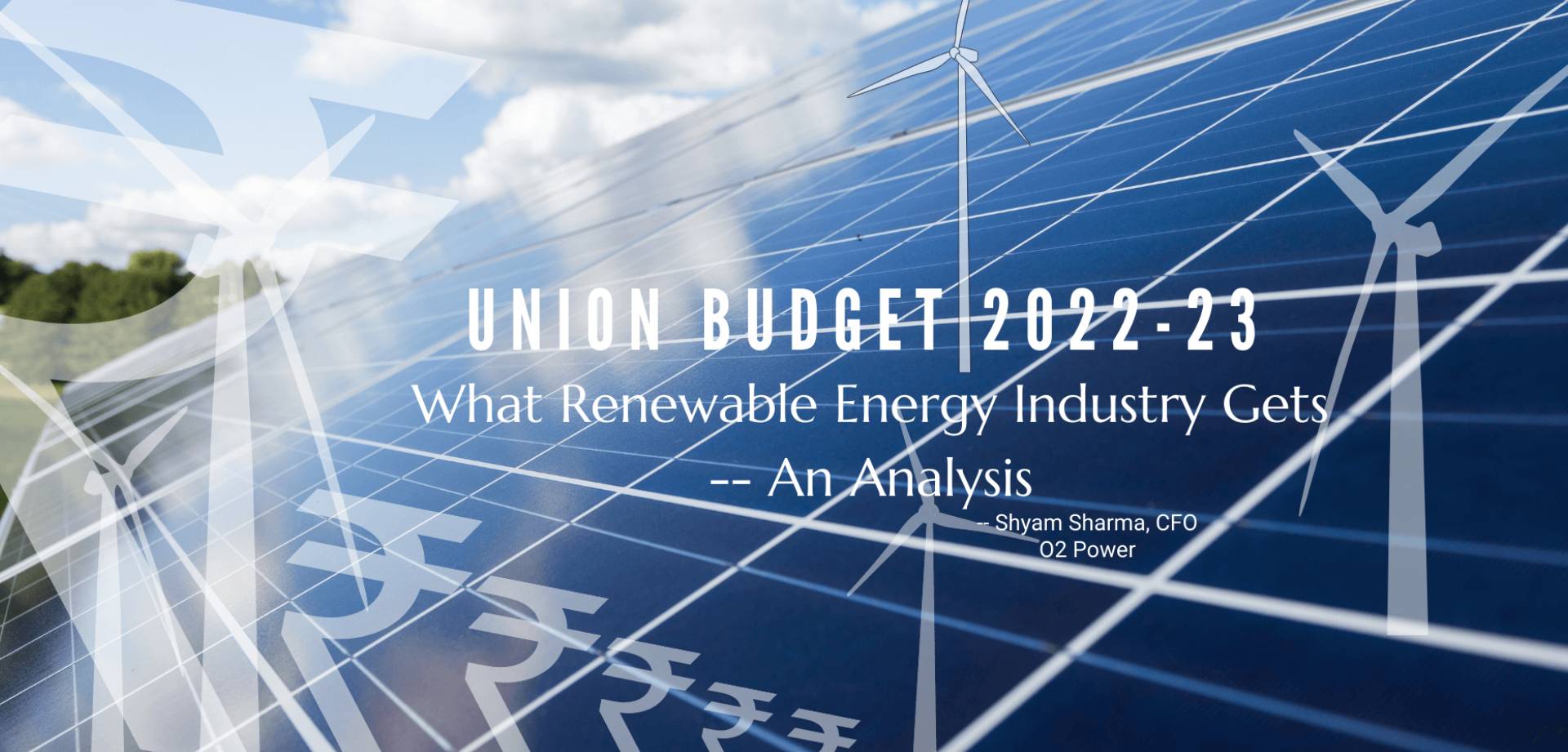
02 February 2022
Union Budget 2022-23 – An Analysis of What Renewable Energy Industry Gets
Authored by Shyam Sharma, CFO – O2 Power
- Posted at 06:00 PM in Renewable by Admin
- 0 Comment
- 4 Likes
Overall, Union Budget 2022-23 is, for all practical purposes, the Part II of last year’s budget! With further focus on higher growth, increased capital expenditure on infrastructure development, emphasis on domestic manufacturing through extension of PLI schemes to support climate change initiatives and supporting rural economy, it reflects Government of India’s long-term focus on being consistent with its objective of achieving higher growth and not get hindered by worries of controlling the fiscal deficit. The budget provides a sharpened focus on the ‘new economy’- drones, artificial intelligence / digitalization, climate control and environment, 5G Technology and EVs.
Like last year, the emphasis is on solving the supply side constraints by allocating additional 35% towards capex on Infrastructure (allocation of 7.5 lakh crores). This will boost productivity and employment generation for sustainable economic growth due to its multiplier effect. Minimal changes in tax laws and government’s intent to maintain consistency will help businesses to keep working towards their growth plans. The absence of demand side push by making more surplus available in the hands of individuals is one of the biggest misses of the budget. Here’s a snapshot of what Union Budget 2022-23 brings for us in the renewable energy industry:
Sector Announcements:
- Allocation of additional INR 19,500 crores towards Production Linked Incentive scheme to help module manufacturers to effect complete backward integration from polysilicon to higher efficiency module. This will help our domestic industry to plan higher capacities for both domestic and export markets within the next 2-3 years
- Allocation of INR 1400 crores for solar and hydro projects
- GIFT city to facilitate services for global capital to fund ESG projects
Finance
- Government to issue Green Sovereign Bonds at a lower cost to fund infrastructure needed for climate control initiatives
- To encourage important sunrise sectors such as climate action, deep-tech, digital economy, pharma and agri-tech, the government will promote thematic funds for blended finance with the government share being limited to 20 per cent and the funds being managed by private fund managers
Indirect Taxes
- 40% BCD on Solar PV modules and 25% BCD on PV cells with effect from 1st April, 2022 - This will hugely impact solar projects already awarded and those which are in various stages of construction especially since discoms are not ready to pass on the benefits of change in law to the developers
- Concessional BCD rate of 5% being phased out for wind operated electricity generator, its parts and accessories w.e.f 1st April, 2022. This will result in higher cost of wind turbines
- Grid-scale battery systems will be included in the harmonized list of infrastructure. This will lead to reduction in the indirect taxes on battery energy storage system (BESS)
Direct Taxes
- No change in corporate tax rate
- Extension of 15% corporate tax rate for new domestic manufacturing companies by one year to 31st March, 2024 - I had mentioned this in my pre-budget wish list (Union Budget 2022-23 – Expectations of the Renewable Energy Industry ), and am very happy this has been granted. It is a big relief to the industry for under- construction RE projects which have been delayed due to covid and GIB
- Rate of surcharge restricted to 15% (from highest 37%) in the following cases:
- Long-term capital gains arising from transfer of any capital assets - This will help in reducing tax liability on the investors / employees owning shares at the time of exit.
- Association of Persons (AOP) where all the members are companies - This will reduce over all tax liability in case of bidding in a consortium of corporates
Road Ahead
On the whole, therefore, a budget that truly looks ahead especially with respect to its green commitments, creating new solar manufacturing facilities and related infrastructure strategy. Towards this, an allocation for Viability Gap Funding (VGF) to make green hydrogen, offshore wind and battery storage viable and commercial, as was done in the initial years of the solar journey, would have provided a further fillip to India’s net-zero ambitions. We hope this will be addressed in the days ahead.

Leave a comment